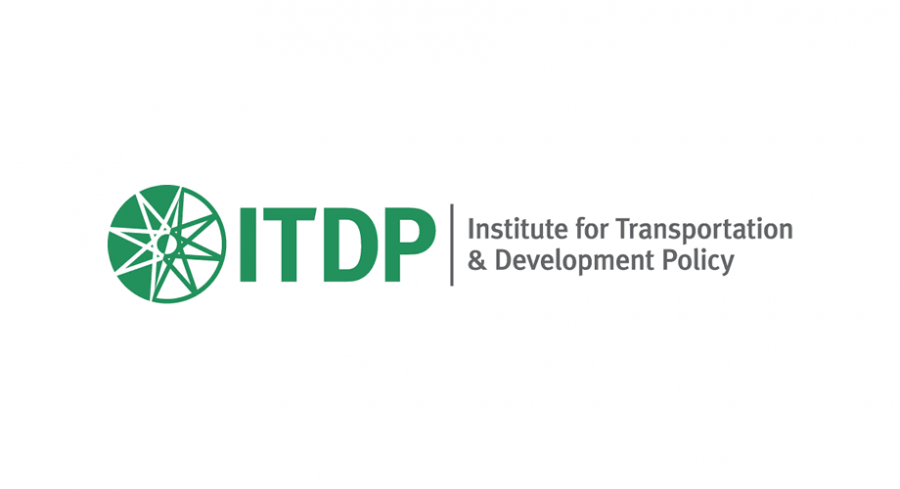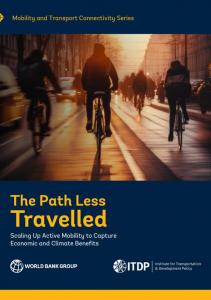
World Bank and ITDP Report Calls for More Investment into Active Mobility Infrastructure in Cities
Report highlights the crucial role of cycling and walking infrastructure in cities for improving mobility, promoting access, and addressing the climate crisis.
WASHINGTON DC, UNITED STATES, January 16, 2024 /EINPresswire.com/ -- Cycle infrastructure networks are among the most cost-effective approaches to improving urban mobility and reducing greenhouse gas emissions from urban passenger transportation. A new report from the Institute for Transportation and Development Policy (ITDP) and the World Bank makes the case for expanding urban cycling and pedestrian networks to support broader sustainable transport and economic development goals. It also presents a call to action for development banks, governments, and civil society to better coordinate and scale investments into active mobility infrastructure.
Cycle infrastructure is relatively quick to build compared to other transport infrastructure. As a result, it generates climate, health, and economic benefits in the near term, often paying for itself over just a few years. Despite the benefits of active mobility, few developing country cities have a complete network of protected bicycle lanes, or the sustained funding needed to develop and maintain cycle infrastructure at scale. National-level active mobility infrastructure plans are rare and inconsistently funded. While large-scale interventions to grow cycling and public transport trips deliver significant, quantifiable benefits that dwarf upfront costs, most governments have not institutionalized such plans.
The joint ITDP and World Bank report, "The Path Less Travelled: Scaling Up Active Mobility to Capture Economic and Climate Benefits", presents a review of five city case study projects of Addis Ababa, Ethiopia; Buenos Aires, Argentina; Dar es Salaam, Tanzania; Lima, Peru; and Tianjin, China to make the case for more public and private collaboration in support of active mobility infrastructure. The case studies show that scaling active mobility investments is possible and offers climate and economic benefits for cities that can outweigh the costs. Investment in cycle infrastructure not only grows cycling usage and connects people with opportunities but also supports other goals, such as expanding public transport ridership and revenue, improving traffic management, and improving road safety.
The paper presents urgent calls to action for all stakeholders to help coordinate and scale investment in active mobility infrastructure. Transport and urban development stakeholders must build more cohesive coalitions to increase investment in climate-driven active mobility projects. Strong coalitions will be essential to uncover and communicate knowledge and process gaps, needs for tools or analytical frameworks, opportunities to co-finance projects, and more. Furthermore, blended financing that leverages development banks, the private sector, and national government capital presents active mobility as an attractive and worthwhile investment opportunity.
“There is a strong economic rationale to invest in active mobility: bike lanes are a clean, healthy, and efficient mobility solution for cities, complementing public transportation programs well. This is why countries and cities should act swiftly to scale up their activity mobility networks and secure financing to deploy them more extensively,” said Nicolas Peltier-Thiberge, Global Director for Transport at the World Bank. “The World Bank is already working with several client countries such as Peru, Tanzania, Brazil, Colombia, Senegal, and Argentina on active mobility infrastructure investments and policies. These projects help establish best practices, which we use to scale active mobility and further decarbonize transport in more developing country cities.”
“There is a growing body of evidence that demonstrates the significant returns on investment that cycle lane networks can offer our cities,” said Heather Thompson, CEO of ITDP. “Now, it is about making the case for more collaboration among development banks, philanthropy, and investors to commit to large-scale active mobility projects in every city. This is crucial if we want to expand urban mobility, reduce emissions, promote accessibility, and improve public health.”
Download the "The Path Less Travelled" report here.
The Institute for Transportation and Development Policy (ITDP) is a global nonprofit that works with cities worldwide to design and implement high-quality transport systems and policy solutions that make cities more livable, equitable, and sustainable.
The World Bank is one of the world’s largest sources of funding and knowledge for developing countries. Its five institutions are committed to reducing poverty, increasing shared prosperity, and promoting sustainable development.
Veronica Ortiz
ITDP
veronica.ortiz@itdp.org
EIN Presswire does not exercise editorial control over third-party content provided, uploaded, published, or distributed by users of EIN Presswire. We are a distributor, not a publisher, of 3rd party content. Such content may contain the views, opinions, statements, offers, and other material of the respective users, suppliers, participants, or authors.




